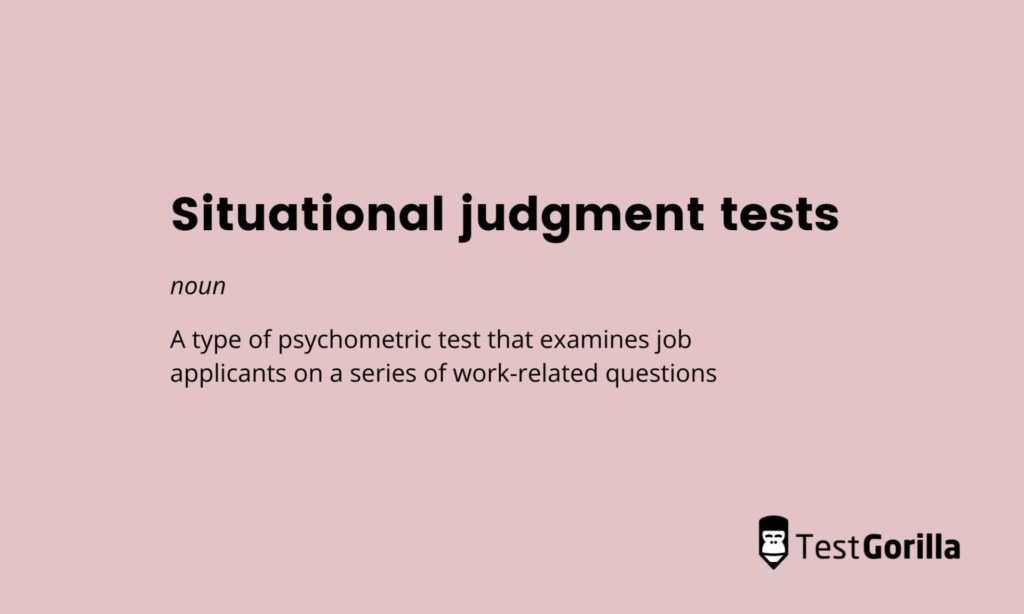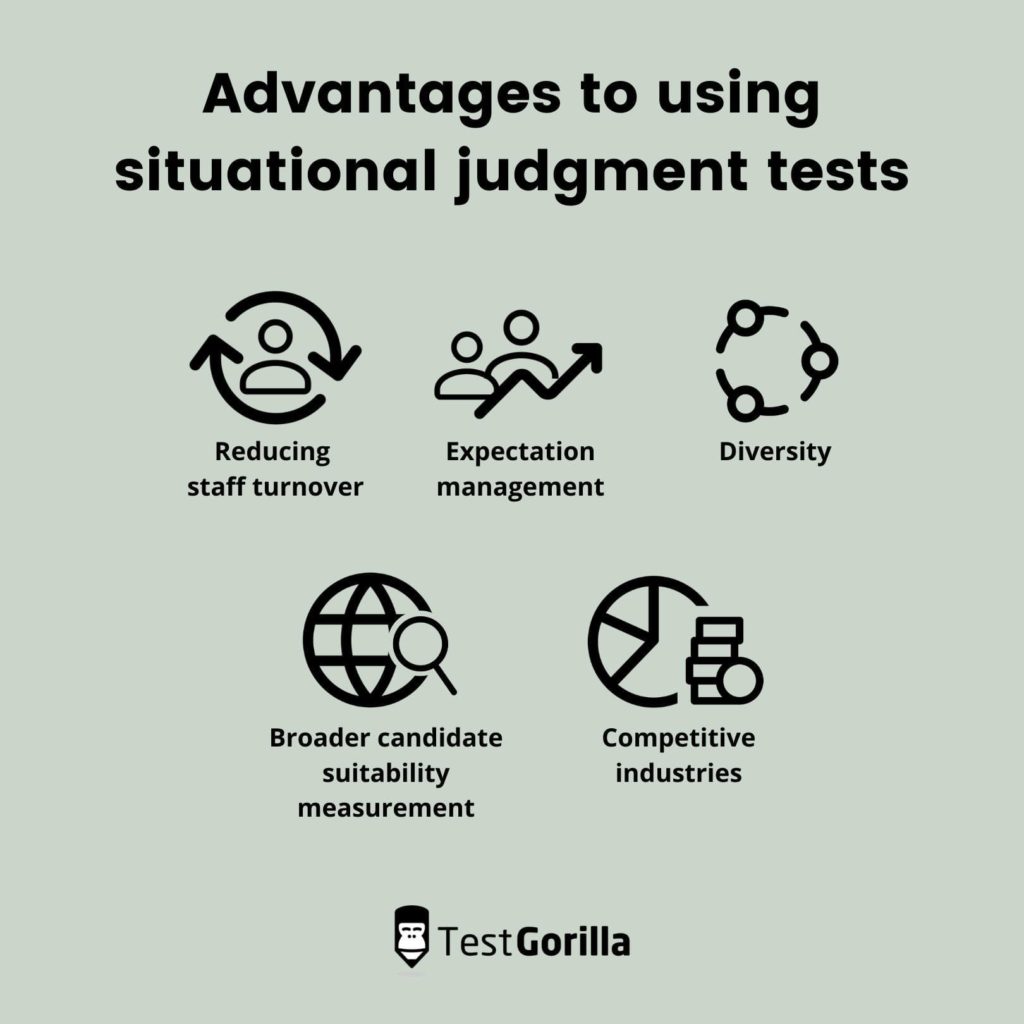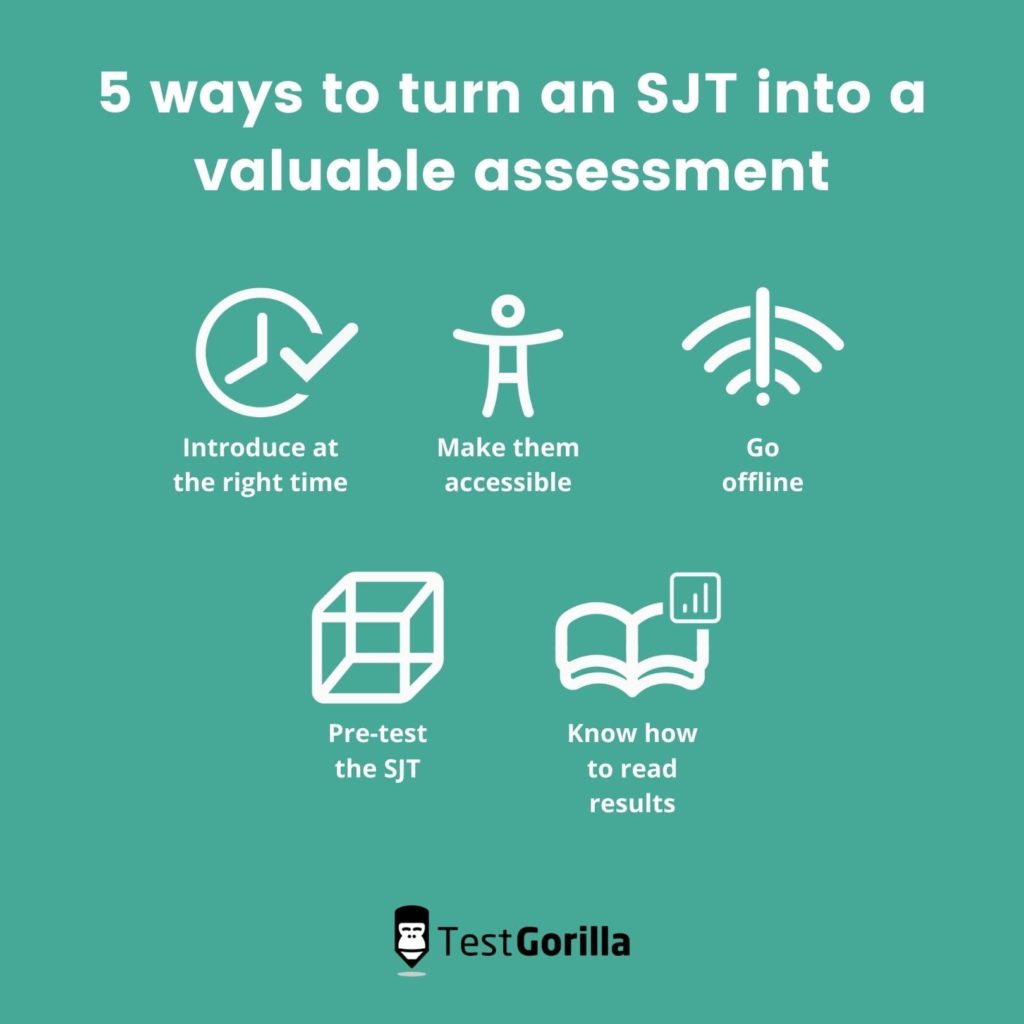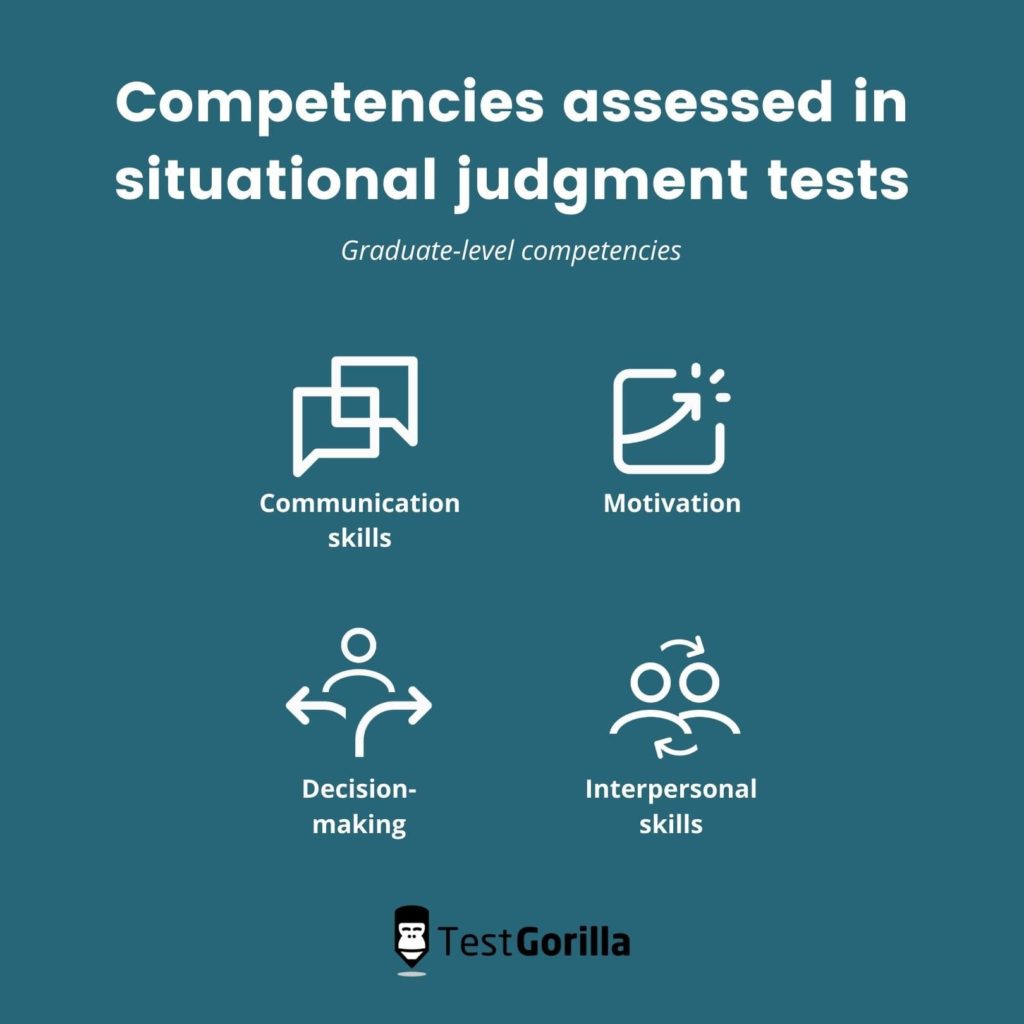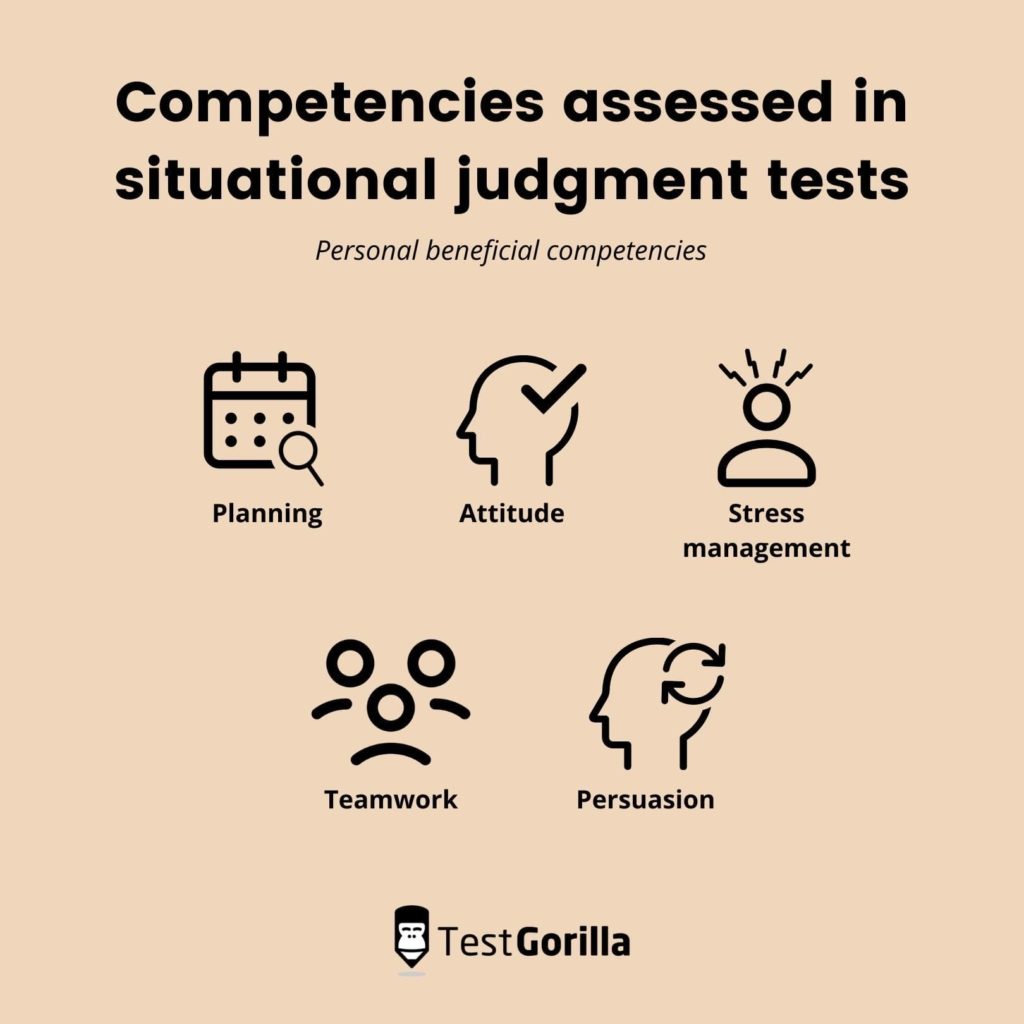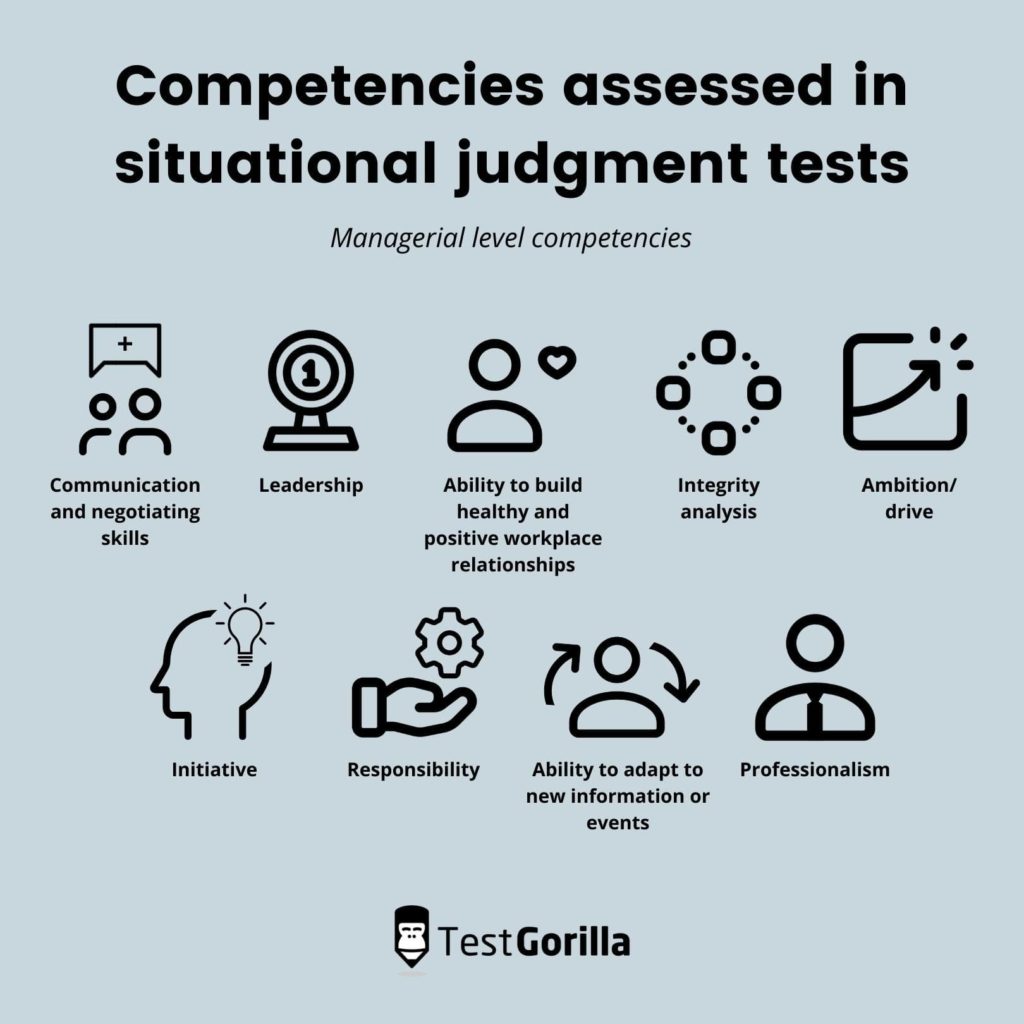Situational judgment tests (SJTs) are a frequently used assessment technique in employee selection.
They are now a very common element of recruitment processes. They are used by employers to shortlist from a large number of candidates for a vacant position.
Employers and job candidates alike are interested in how SJTs work and what they include.
This in-depth guide details how SJTs compare to traditional hiring techniques, the challenges of using SJTs, and how businesses may integrate them into the hiring process.
Table of contents
- What are situational judgment tests?
- What do situational judgment tests measure?
- Why are so many businesses using situational judgment tests now?
- How do situational judgment tests compare to traditional interviewing techniques?
- 5 ways to turn a situational judgment test into a valuable assessment
- Use of situational judgment tests in learning and development
- How to integrate situational judgment tests into the recruitment process
- Challenges of using situational judgment tests
- Common mistakes with situational judgment tests
- Make situational judgment tests as part of your recruiting process
What are situational judgment tests?
Situational judgment tests (SJTs) are a type of psychometric test that examine job applicants on a series of work-related questions. They can be written, audio-visual, or making use of alternative forms of media. They may or may not be timed.
The questions in the test mostly include hypothetical scenarios that are close to the challenges candidates may encounter during their day-to-day work if hired. The answers are often multiple-choice, and test-takers are asked to choose the answers they believe to be the best responses in the given scenarios.
In this way, SJTs measure an applicant’s ability to react well in difficult and stressful situations. Those situations may involve workload issues, difficult colleagues, or even ethical dilemmas.
The reason why these are so effective is that, unlike more generic psychological tests, situational judgment tests are tailored to specific roles. They incorporate questions that directly relate to the needs of the position, and so remain the preferred testing method for employees and candidates alike.
What do situational judgment tests measure?
SJTs test competencies, and there are plenty of competencies to test!
The bespoke nature of SJTs means that hiring teams can pick and test the relevant competencies straight from the job description. Although SJTs are highly flexible, the following competencies are tested most commonly by employers:
Leadership skills
Resilience
Organization and planning
Decision-making
Communication skills
Although a wide range of generic versions of SJTs exist, many companies prefer to use a customized collection of SJTs in the recruitment process. For example, for a sales vacancy, an employer could opt for a sales-focused SJT that would assess candidates on skills relevant to a sales role, such as rapport building and negotiation.
SJT templates that are commonly available are often designed in accordance with different job levels.
There are graduate-level SJTs, versions that test for personal beneficial competencies, and SJTs for managerial positions.
If you don’t have the time or expertise to design an SJT package, generic versions can provide high value.
Recommended reading: Top situational judgment skills that are essential for your team
Why are so many businesses using situational judgment tests now?
The first situational judgment tests were introduced in the 1950s. Throughout the 50s and 60s, the healthcare and military industries were steady adopters of the hiring test. In the 1990s, more industries were starting the introduce SJTs into their hiring process.
Now, more businesses than ever are using SJTs, and the reason is largely down to technology.
It’s never been easier to integrate situational judgment testing into the recruitment cycle. The growing advancements in Data Science, Cloud Computing, and ML/AI, have turned SJTs into the innovative recruitment tool that delivers actionable results.
There are multiple advantages to using SJTs.
1. Reducing staff turnover
One of the most cited reasons for using SJTs is that they can be used to effectively cut down on high employee turnover rates.
By using SJTs, recruiters can improve the quality of every hiring decision. With the right person placed into the right role, they will be happier, more aware of their responsibilities, and introduced to the workplace culture faster.
SJTs can predict the performance of a job candidate. If testing reveals that one candidate has the necessary skills to do the job as well as the enthusiasm to perform well, staff turnover can be dramatically reduced.
When a candidate produces positive results on a tailored SJT, then it’s likely that they will be a great fit for the vacancy.
2. Expectation management
It can be nerve-wracking starting a new job. Walking in on your first day, working through the onboarding process, and then being faced with your new responsibilities: it can all be extremely stressful.
SJTs can ease that stress. It’s not just employers and HR teams that like SJTs. Job seekers are always going to be curious about the realities of any job they’re applying for. SJTs allow those applicants to get a real-world preview into the job and the workplace. A professional SJT will be like a preview of the job and can highlight what’s great about the role and what is likely to be challenging.
The mismanagement of expectations is one of the main reasons for high staff turnover.
By showing candidates more of what the work environment and cultures are like, as well as a more insightful look into their day-to-day responsibilities, those candidates know a lot more about what to expect from day one.
3. Diversity
More diversity in the workplace means a faster, more agile, and more dynamic business. Productivity is improved, and employers also benefit by having a larger talent pool to find recruits.
SJTs are, in most cases, anonymised. The recruitment team will not have any details about the person whose test is being scored. The result is that those recruiters will not have any unconscious bias coming into play. It levels out the recruitment process because it eradicates the risk of a more uniform and generic workplace where everyone looks and thinks the same.
Even traditional psychometric testing is less able to deliver proactive diversity outcomes.
4. Broader candidate suitability measurement
There are plenty of tools and resources available for HR teams and recruiters. Each of those screening tools will measure a specific range of workplace qualities. Where SJTs differ is that they are more versatile and can measure candidates from a broader perspective.
When designed well, a situational judgment test will make it easier to identify how well a candidate is able to deliver on the basics requirements of the advertised role. These requirements can include technical proficiencies, but also basic competency frameworks.
SJTs are also critical for evaluating candidates simply because they can highlight the candidates who are likely to have the citizenship behavior traits that will make for a more positive workplace.
If SJT testing reveals that a candidate is not likely to help or advise colleagues, or that they have no interest in career development, then that’s a sign that an alternative candidate may be a better fit.
While traditional psychometric tests are fantastic for predicting task-based performance, SJTs are more reflective of the daily realities of any job.
By introducing workplace scenarios early into the hiring cycle, you immediately give candidates the insights they need, while earning the insights that the recruiter needs.
5. Competitive industries
Some business sectors are experiencing employee drought. There are simply not enough experienced, qualified employees available. Employers have to use a wide range of strategies to attract the candidates they need, particularly in the tech sectors.
These brands need to differentiate themselves from their competitors. SJTs help them to do this.
By introducing candidates to the perception of the workplace culture, those candidates get the real insights they need. They can determine more easily if an employer is a right fit for them. It’s like having a more realistic preview of the work culture.
Candidates can then make better choices when deciding who is best to work for. It also allows businesses to stand out from the crowd.
How do situational judgment tests compare to traditional interviewing techniques?
Interviews remain useful because they provide benefits to employers and candidates alike.
Employers consider the interview process indispensable because they can:
Assess the experience of candidates and develop an understanding of how well they are likely to perform in the role
Take the opportunity to explain more about the role and the organization, while highlighting employee benefits and career progression opportunities
Reinforce positive brand impressions and highlight the organization as somewhere the candidate would want to work
For candidates, too, interviews hold value. They allow those candidates to:
Fully understand the responsibilities and duties of the position
Ask relevant questions
Evaluate whether the workplace will suit them and whether they are capable of the duties of the role
However, interviews have serious limitations too. They are particularly prone to unconscious bias, which seriously disadvantages some candidates over others.
This does not mean that businesses should stop interviewing candidates altogether. Instead, they should recognize that interviews are susceptible to certain drawbacks such as:
Interviewers asking questions that are intended to confirm the first impressions of a candidate, even before the interview has started.
Interviewers assuming that the characteristics of a candidate are representative of any group. Even though discrimination is illegal in the hiring process, the fact remains that unconscious bias affects interviewers, and results in people being judged for their age, gender, disability, or class.
If the response to a question is somewhat unfavorable, interviewers are more inclined to rate possible candidates as either good or bad. As the interview continues, initial impressions are likely to be reinforced, even if all following questions result in positive responses. This is known as the halo and horns effect.
Interviewers may suffer from the contrast effect, which is when they interview one candidate and allow that interview to cloud their judgment during any subsequent interviews for the same position
There are other flaws, too, in the interview process. Interviewers, despite their best intentions, often fall into the similar-to-me effect trap. This means that they are more likely to view a candidate positively if that candidate has similar interests, background, experiences, or attitudes. There’s even the personal liking effect phenomenon, where candidates can get selected or dismissed based on how well they get on with the interviewer.
Tackling these potential issues runs the risk of turning the interview process into a cold and sterile experience that offers little to no benefits for the interviewer, the organization, or the candidate. That is where integrating situational judgment tests into and around the interview process can support all stakeholders by providing significant insights.
Ideally, SJTs are used to shortlist candidates long before interviews are held. This allows interviewers to have some awareness of each candidate’s strengths and weaknesses before they meet. It also means that the shortlisting process itself is not vulnerable to bias or interviewer preferences.
When used smartly, situational judgment tests can go a long way in solving traditional problems associated with the hiring process. Their accuracy in assessing the abilities of candidates has been proven again and again.
Of course, SJTs on their own do not suffice for recruiters, and they can not replace interviews. Instead, they are to be used as a strong component of the hiring process, and as a tool to provide structure to traditional hiring techniques.
5 ways to turn a situational judgment test into a valuable assessment
An SJT would certainly provide value to any HR team given that it is used in the right way.
Here are the best five ways for businesses to get more value from their SJTs:
1. Introduce testing at the right time
There are lots of opportunities in the hiring funnel for SJTs to be introduced. The final decision is made in accordance to how many applicants there are. This, in turn, depends on the size of the organization, and the position that is vacant.
Companies with rolling vacancies, high turnover rates, or those growing quickly, should use testing early. By introducing SJTs fast, HR can quickly cut down on the number of applications they have to read through. Moreover, unqualified candidates can be informed automatically that their application has been unsuccessful, leaving HR free to move quickly to the next stage of the selection process.
2. Make them accessible
Companies should have various formats of SJT available for use depending on how different applicants are able to access the test. For example, some people may not have a desktop PC and would like to take the test using their phones. Here, HR needs to ensure that device compatibility is optimized.
There also needs to be a consideration of applicants with special needs, and the business must ensure that all candidates can easily understand and submit the test. That way, companies get an accurate view of the applicant pool and can save themselves from overlooking their best potential hires.
3. Go offline
This is a little trickier from a technical perspective.
The goal for any test-maker is to make it as difficult as possible to game the system or cheat. If recruiters don’t consider the possibility that some people will try and gain an advantage over others by Googling questions and their answers, they will end up with skewed results. If not caught later, this might even lead to the company making the wrong hire.
For online situational judgement tests, in particular, cheating is something that needs to be considered. It’s not unknown for candidates to find ways to improve their SJT scores. Common methods induce getting someone else to answer the questions or having a team around to help identify the best answer.
This can be hard to counter for HR. One option that is becoming increasingly common is to introduce two stages to the assessment. The first will be introduced early in the hiring process. The other will take place later and in a more controlled environment (such as before an interview).
The problem with those that cheat on SJTs is that HR is then more likely to make the wrong hire. A lack of workplace fit, or even hiring someone that simply lacks the core competencies of the role, means a more vulnerable business. The turnover rate will begin to rise, and productivity will start to fall.
4. Pre-test the SJT
Before companies let candidates take the test they have designed, they must test it themselves. Getting employees already in the roles being advertised can ensure that questions are realistic. Moreover, any technical issues or mistakes can be identified ahead of time.
5. Know how to read results
If a business is analyzing SJT results in-house, they must make sure that the analysis is being carried out by a trained specialist.
A company can have the most impressively designed SJT possible, but if HR does not know how to interpret it, they are inevitably going to make hiring mistakes. Realizing this, businesses most commonly outsource SJT testing to specialists.
Use of situational judgment tests in learning and development
As SJTs are largely used for recruitment, their value as a learning and development tool can often get overlooked.
Ideally, they shouldn’t only form part of the company’s general recruitment strategy, but also be utilized for in-house development. For instance, if a line manager identifies an existing member of the team as being well-suited for promotion or development, testing can reinforce that decision.
When should companies employ situational judgment tests?
There are specific competencies that can be best evaluated using targeted SJTs. These can form the foundation of any situational judgment test package.
Graduate-level competencies
College-level graduates can be tested for core competencies that reflect the primary abilities and skills that one would expect to find in an entry-level role.
Entry-level roles are unlikely to require any experience with management skills, and are instead focused on:
Communication skills: This includes written and spoken communication and negotiating skills. Testing these highlights those candidates who can present their ideas and their work in a clear and organized fashion, and are able to persuade others to reach a stated conclusion;
Motivation: Entry-level workers tend to be required to work harder to leave a mark. By evaluating motivation, employers can assess whether an applicant will be able to meet deadlines while providing consistently high levels of work;
Decision-making: This part of an SJT looks at how candidates reach conclusions based on the information they have and their confidence in making those decisions;
Interpersonal skills: One of the main criteria of SJTs is working out how well-suited a candidate is to the culture of a workplace. This part analyzes the candidate’s ability to build and maintain professional relationships, in order to foresee future relationships with customers, managers, and co-workers.
Personal beneficial competencies
For administrative or customer service roles, the competencies that are assessed include some of the same ones as those included in graduate-level SJTs. Other than those, they also cover:
Planning: This will be looking at how well someone approaches tasks. It will highlight whether they use a systematic approach to organization, and note whether candidates can prioritize efficiently, stick to guidelines, and ultimately manage their time well.
Attitude: For customer-facing employees, in particular, attitude is of vital importance in the workplace. How a candidate responds to clients and coworkers is a vital insight that can go a long way to encouraging higher work standards.
Stress management: Admin and customer service roles will often find themselves in stressful situations. This could be in the form of an angry customer or rapidly approaching deadlines. By testing for stress management, employers can more clearly see how someone responds to work-related pressure.
Teamwork skills: It’s important for companies to know a candidate’s approach to teamwork. The key is to identify whether the applicant sees team goals to be as (if not more) important than the goals of the individual.
Persuasion: Persuasion is another extremely useful metric to assess. Whether or not a candidate is capable of influencing clients to purchase products can be the difference between an excellent sales employee, and an unsuccessful one.
Managerial level competencies
A standard SJT package that focuses on managerial competencies looks slightly different from the two packages previously discussed. Management SJTs allow employers to test the judgment of applicants, and how they would respond to difficult situations.
Often, managerial SJTs are used very early in the hiring process so that candidates who do not have the requisites can be eliminated.
SJTs designed for managerial positions are usually delivered without a time limit, since the given scenarios are challenging. Applicants are often, however, encouraged to be as spontaneous as possible when answering the questions they are presented with. The core competencies that are looked for in dedicated managerial SJTs include:
Communication and negotiating skills
Leadership
Ability to build healthy and positive workplace relationships
Integrity analysis
Ambition/drive
Initiative
Responsibility
Ability to adapt to new information or events
Professionalism
How to integrate situational judgment tests into the recruitment process
SJTs are relevant for certain business models more than others. The businesses that can benefit from them most in their recruitment processes are:
Businesses that always sees a high volume of applicants since SJTs are cost-effective and time-efficient.
Businesses advertising for roles that are clearly defined as that would mean that there could be a clearly defined set of competencies in the test. The clearer a profile the business has of an ideal candidate, the more effective the SJT can be.
Businesses that use a defined and structured work process get a lot of value from using SJTs. The SJTs used for such companies evaluate the performance of a candidate within the specific construct of that business and vacancy.
Businesses that are focused primarily on hiring graduates and entry-level positions can at times benefit from SJTs even more than those hiring specialists, as experienced applicants have a tendency to use their experience to determine the answers that the employer must be looking for.
Businesses with high levels of competition can stand out from the crowd more easily. If a brand is struggling to recruit the right people and keeps losing great candidates to its competitors, SJTs can help. With their accuracy and the speed of the analysis, SJTs can have a faster recruitment process. In competitive talent sectors, SJTs give employers an advantage over those businesses using slower, less effective selection processes.
Although there are no fixed rules for it, where and when a business conducts the SJT within the hiring process is critical. Some businesses put situational judgment tests front and center of the hiring process.
An applicant will fill out their application and receive an immediate public link that takes them to the test. This is a good option to consider because it helps cut down on time wasted in sorting through resumes of applicants who simply aren’t suitable.
Other businesses delay SJTs and do not conduct them until much later in the recruitment process. It’s also increasingly common for SJTs to take up part of the actual interview process. While this does hold value, it’s a lot less effective than an earlier introduction to judgment tests, as it may mean that the interviewer will be evaluating the results during the interview itself.
No matter where in the hiring process the SJT has been integrated, it is crucial to have a comprehensive understanding of them. That means making sure that:
Recruiters or the persons in charge of administering the tests have been trained;
The test has been designed to be relevant to the role;
There is a clearly defined hierarchy that dictates who chooses, administers, and then evaluates the results of the test;
The tester and the hiring team know how to use the results of the tests;
Feedback on testing is delivered, both, to the candidate and the hiring team.
Choosing the right type of SJT
Sometimes, SJTs will be a simple pen and paper test. Other types may include multimedia tests that include job simulation videos or graphics. No matter the format a company uses, the complexity of questions will vary according to the role and its requirements. The more demanding the role, the more complex the SJT should be.
What are the most common SJTs used?
There are two main formats for SJTs:
Multiple choice: Applicants complete the test with a pen and paper or they use online resources. Whichever is used, the format of multiple-choice tests is the same. Candidates are presented with a list of scenarios and some optional answers to choose from.
Video tests: Although these use an entirely different medium, video or interactive SJTs nevertheless use the same system for testing. In these, applicants see scenarios being played out on the screen, and then choose the best response to that situation. This is a more interactive SJT.
Carry out a job analysis
The first step to designing an SJT is understanding the role that’s going to be advertised. The manager or supervisor can list responsibilities, and the HR team names the skills needed to carry out the role at a high standard.
Next, the hiring team talks to high performers currently in that role. If the vacancy is for a new position, the hiring team needs to conduct outreach to role experts and subject matter experts to fully understand the job narrative. The ultimate goal is to gain an understanding of the daily experience of that role and gather examples of negative and positive work experiences and situations.
Once all the information is gathered, it can then be used to personalize the questions in the SJTs. The test will now be more beneficial for both the recruiter and the candidates.
Creating ideal candidate profiles
The hiring team uses the job analysis to create an ideal candidate profile. This profile should include a list of the competencies that are must-haves for the candidate and another list that includes nice-to-haves. Such a list can be incredibly useful if the hiring team is expecting a high number of applicants. In that situation, the profile can be used to effectively streamline the shortlisting stage.
Testing and validation
The hiring team will next need to create a scoring key. This is what the finished SJT is evaluated against. To create the scoring key, the hiring team needs to have the SJT evaluated by HR leaders, role experts, and the highest performers in the relevant department. The experts will study the test and determine what their response to each question would be. This helps the hiring team to confirm that they have created the most appropriate testing and validation strategy and that the SJT itself is effective.
It’s also possible to use statistical analysis to score assessments. This can be carried out during the hiring process, with the team gathering real-time data as candidates complete their tests. As that data is analyzed, it can be used to improve the testing system and more effectively reflect the predictors of high-value job performance.
Structuring the SJT
This plays a large role in determining the validity of an SJT. Once the employers have decided on the kind of SJT they want to use, they then need to determine its parameters. Using the job analysis that’s already been carried out, they must decide how many questions are to be included and how long candidates have to complete the test.
Some organizations allow candidates to complete tests at their own pace, with no time limit. This helps candidates by lifting the pressure to answer quickly. That said, having a time limit has its own benefits, especially if the test is for a high-pressure position. A time limit can add extra insights into how well a candidate might respond during challenging times.
How to create SJT scenarios
After the hiring team has drawn up their ideal candidate profile and conducted a thorough job analysis, they start to design the scenarios that will appear on the SJT. The general strategy is to create scenarios that have been highlighted by existing employees (or role experts) as being real situations likely to occur.
It can be tricky to come up with scenarios that are both, specific enough to be believable, and ambiguous enough to reflect the unpredictability of any workplace. If test-makers succeed, it becomes notably easier to engage the critical thinking and/or decision-making skills of each candidate.
It is also important that the wording of the test be precise. Word choices can be very pivotal in SJTs, and can negatively or positively affect the choices that a candidate makes on the test.
Challenges of using situational judgment tests
SJTs are not without their risks. There are many challenges to tackle when it comes to implementing SJTs into the recruitment process.
The main challenges are:
1. Skewed results
Although psychometric testing is universally considered to be one of the most reliable ways to assess potential employees, the results can still suffer from a lack of accuracy. One major reason for this is the time limits these tests are conducted within. They add a lot of pressure on applicants, which can easily lead to scores that are not representative. Underperformance is a real risk when using timed SJTs.
2. No defined measurements
An SJT is only going to have value and be considered successful if the person analyzing the results knows what they’re measuring. SJTs need to be planned so that they match the vacancy as much as possible.
3. The costs
One can go online, download an SJT template and pass it on to candidates without incurring any expense other than printer ink. Needless to say, the results of such an approach are going to be extremely limited.
If a business wants more effective situational judgment testing, it’s a smart move to have theirs designed, administered, and then analyzed by professionals in the psychometric field. Of course, that adds to the business’ recruiting budget, and it’s no surprise that smaller businesses are wary of spending extra money on SJTs when recruiting.
What those smaller businesses overlook, however, is that SJTs make it easier to make the right hire. That candidate is going to be more likely to stay longer with the company, slashing turnover costs.
The right SJT can even help cut down on training costs, because candidates may already have been trained in the relevant areas. Owing to these factors, it could help businesses to think of SJTs as an investment rather than an expense.
Common mistakes with situational judgment tests
As valuable as SJTs are, inexperienced recruiters are likely to need time to understand how they work before they have mastered how to administer them.
Some of the most common blunders that HR needs to avoid when working with SJTs are:
1. Sole evaluation
Recruiters that base all of their recruitment decisions on SJT results are likely to make hiring errors. Evaluating a candidate needs to be more holistic than simply looking at test scores and hoping for the best.
For SJTs to be effective, they need to be used alongside other elements of the hiring journey. In other words, SJTs should inform interviews, not replace them.
2. Lack of targets
One of the most common mistakes made by recruiters is the lack of objective, tangible measurements. Every SJT needs to have a goal, and that means knowing exactly what the business wants from candidates.
Without a defined goal, recruitment can fall victim to bias. Recruiters looking at the test results without any measurement will look for answers that match what they believe is ‘right’. This can cost the company the best candidates.
3. Binary analysis
Being overly binary with the results and data of SJTs is all too common. The very basis of SJTs is that they are ‘situational’.
Candidates may give one answer to a question today but give a different answer to the same question tomorrow, and recruiters need to keep this in mind.
Recruiters must remember that the initial reading may not give the whole picture, and avoid adopting a black-and-white approach towards results. For instance, if a role being tested for involves contact with customers, they should not automatically dismiss candidates whose test results show them to be introverted. Instead, this information can be further explored and discussed in an interview.
Make situational judgment tests as part of your recruiting process
There has been a lot of research on the effect and value of SJTs. Research has shown time and again that when used correctly, these tests are extremely useful, and let employers predict the results of a hiring decision.
In turn, both the recruitment process can be accelerated, and costs can be cut in the process of hunting and retaining the most suitable people for each position in a given company.
With TestGorilla, you’ll find the hiring process to be simpler, faster, and much more effective. Get started for free today and start making better hiring decisions, faster and bias-free.
Related posts
Hire the best candidates with TestGorilla
Create pre-employment assessments in minutes to screen candidates, save time, and hire the best talent.
Latest posts
The best advice in pre-employment testing, in your inbox.
No spam. Unsubscribe at any time.

Hire the best. No bias. No stress.
Our screening tests identify the best candidates and make your hiring decisions faster, easier, and bias-free.
Free resources
This checklist covers key features you should look for when choosing a skills testing platform
This resource will help you develop an onboarding checklist for new hires.
How to assess your candidates' attention to detail.
Learn how to get human resources certified through HRCI or SHRM.
Learn how you can improve the level of talent at your company.
Learn how CapitalT reduced hiring bias with online skills assessments.
Learn how to make the resume process more efficient and more effective.
Improve your hiring strategy with these 7 critical recruitment metrics.
Learn how Sukhi decreased time spent reviewing resumes by 83%!
Hire more efficiently with these hacks that 99% of recruiters aren't using.
Make a business case for diversity and inclusion initiatives with this data.

